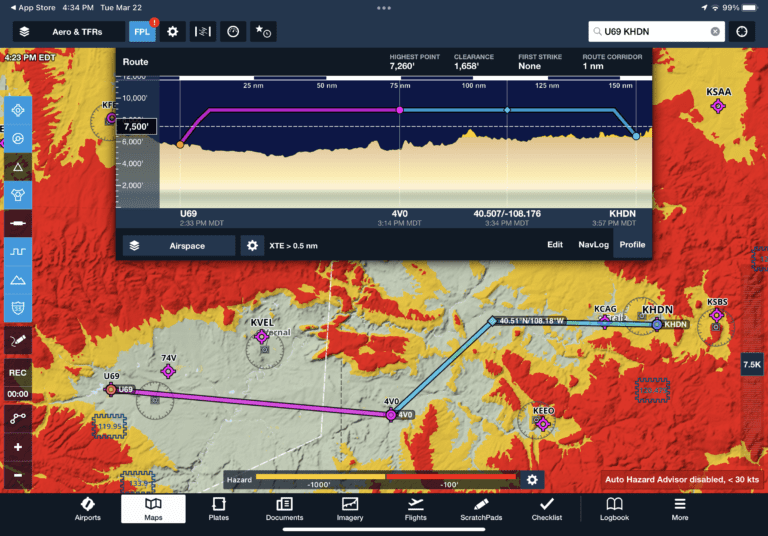
ForeFlight recently released their latest app update, version 14.2, which improves two of the app’s popular preflight planning tools. In this article, we’ll show where to find the new features and how to make the most of them when planning your next flight.
Here’s a quick summary of what’s new, sorted by subscription plan:
Basic – Enhanced Weight and Balance, Jepp Organized Track Systems
Pro Plus – Hazard Advisor Altitude Preview
Performance Plus – Weight and Balance integrated with Flights
Hazard Advisor Altitude Preview
Hazard Advisor was initially designed as an in-flight safety feature to alert you to terrain near your present position with red and yellow shading on the moving map. You can now use it during preflight too, to help visualize the effects of terrain on various altitude and route options when planning a flight.
This updated feature uses the same Hazard Advisor layer from the main map menu accessed at the top left of the screen, but now you’ll see the addition of the familiar altitude slider at the bottom right of the screen.
The slider moves in 100′ increments up to 4,000′ MSL and 5oo’ increments above that. By default, terrain within 1,000′ of the selected altitude is shown in yellow, and terrain within 100′ or above the selected altitude is shown in red. You can adjust the red/yellow hazard altitudes, along with the corridor width, from the settings button at the bottom of the screen.
To get the most out of this feature, we’d recommend simultaneously displaying the Profile view from the Flight Plan window at the top of the map. This will show an alternate view of the flight with additional details about terrain clearance and obstacle heights. ForeFlight also conveniently keeps both the Hazard Advisor and Profile altitude sliders in sync when you move either one.
When in the air, the altitude slider defaults to the new Auto setting and uses your current altitude for the terrain reference. You can temporarily move the slider to a different altitude to visualize the effects of an altitude change.
Enhanced Weight & Balance
ForeFlight’s powerful weight and balance feature has been around for several years now and is included with all subscription levels. While the feature continues to work well for pilots during preflight, there was a bit of a disconnect with the rest of the app in regard to aircraft profiles. ForeFlight required users to create a second unique N# profile for each aircraft in the Weight and Balance section, separate from the profiles you likely already created in the Aircraft section of the app used for performance planning.
The latest update to the app addresses this and other weight and balance usability issues, in what ForeFlight calls “Enhanced Weight and Balance.” The feature is disabled by default but can be turned on from the Account menu. When viewing the Account screen, you’ll then see a section called ForeFlight Labs, which includes a setting to enable the Enhanced Weight and Balance feature.
Next, open the Weight and Balance utility, which is accessed from the same main menu button. You’ll then be prompted to migrate your existing weight and balance aircraft profiles and match them up with an existing Aircraft performance profile. While this might sound like a hassle, don’t worry, it’s easy. ForeFlight will first guide you through linking the two profiles with a series of questions in the automated migration assistant:
Next, confirm the default weights, limits and station arms, and you’ll be all set:
The updated weight and balance view looks very similar to the previous version, requiring you to enter weights on the left side of the screen and view the results on the right side.
Tap the Summary button at the upper right to generate a load manifest PDF, which can be shared or emailed.
There are some other subtle improvements when adding loads in each seat. For example, you can confirm that an occupant of a seat is a person (vs. cargo), and even select if there will be an infant on the lap of one of the passengers, which will contribute to the filed passenger count.
Performance Plus customers have the ability to access the new Weight and Balance feature directly from the Flights section of the app when flight planning to speed up and simplify preflight workflow. This can be accessed from the Weight and Balance button in the Payload section of Flights:
What else is new in ForeFlight 14.2
 Organized Track Systems on Jeppesen Enroute Charts > Customers with Jeppesen chart coverages can now view and plan with North Atlantic, Pacific, and Australian organized tracks on Jeppesen’s IFR enroute charts.
Organized Track Systems on Jeppesen Enroute Charts > Customers with Jeppesen chart coverages can now view and plan with North Atlantic, Pacific, and Australian organized tracks on Jeppesen’s IFR enroute charts.
Expanded Runway Analysis Support > ForeFlight’s advanced Runway and Obstacle Analysis capability for jets now supports Gulfstream G150 and Textron 525 Citation M2 with Tamarack Winglets.
The post ForeFlight updates Hazard Advisor and Weight and Balance features appeared first on iPad Pilot News.
Source: Ipad appsForeFlight updates Hazard Advisor and Weight and Balance features











